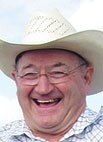
Back in 1926, Larry Cleveland’s grandfather, Lawrence Bailliere, moved to Richland, Mo., from Oklahoma to start a trout hatchery, buying 97 acres with a natural spring.
As time went on, the operation at Ozark Fisheries switched from trout to goldfish and Kio and the need for additional acreage with access to springs, as well as land to protect the watersheds surrounding the operation, grew.
Because the land was mostly timber and of little use in a fishery operation, in the mid-to-late 1950s Bailliere began to develop pasture land and cattle began to graze the rugged landscape, giving birth to the Circle F Cattle Company.
Today, Circle F Cattle Company is a division of Ozark Fisheries, and the joint operation has about 6,700 acres, with roughly 5,700 being devoted to a commercial cow/calf operation of nearly 1,000 females. About 25 bulls are used to service the females through live cover.
Circle F focuses on producing feeder heifers and steers, as well as commercial replacement heifers.
“We keep about a third of the heifers back for ourselves,” Larry explained. “In a way, we are a closed herd because we have been keeping our heifers back all these years. The only new genetics we bring in will be from the bulls.”
Cattle manager Brett Alexander said the quality of the cattle is the top priority at the Circle F.
“We want to make sure our cows are good milkers and good mothers,” he said. “Because we are a cow/calf operation, our income depends on the calves they raise. With our bulls, we like to have heifer bulls that will have that lower birth weight, but we also look at the yearling and weaning weights and try to buy the top bulls. Better genetics pay off on your calf crop.”
Feeder cattle are backgrounded and sold at about 600 to 700 pounds, depending on market situations and feed costs. Larry said over the last 10 years, it is his observation that the steers from the Circle F bring premium prices.
“We have relied pretty heavily on Superior Livestock, which is a good deal for us,” Larry said. “We are able to bring in enough cattle to sell pot loads, opposed to breaking them up. If you can sell a load at a time, in our case two or three loads at a time, you are going to get a much better price from the buyers than if you were just selling a few head. Because of that price, I think our carcass data is pretty good.”
He expects that about a third of the heifers sold by Circle F go into other herds as replacement females. All of the Black Baldie heifers produced as a result of the Anugs/Hereford cross are sold.
Because of the size of the herd, Circle F calves out both in the spring and the fall.
“If we just did fall calving, I’d have to have twice the weaning facilities, twice as many bulls,” he said.
Larry said he wasn’t sure exactly what breed or breeds his grandfather started with, saying there was “a little of everything” and a lot of “experimentation,” including the incorporation of fescue into pastures and building facilities to make moving and working cattle easier and safer.
“We were a fairly large operation at that time compared to our neighbors, and there was money being spent to have facilities designed in a way so that they were intergraded to move cattle from one end of the farm to the other by using lanes,” Larry said.
He added that improved pasture management has allowed the Circle F to increase the weight of calves and increase herd size while utilizing the same amount of acreage.
“We’re just trying to make it more productive,” Larry said. “We’d like to have about 1,250, 1,300 head over the next five years. In order to do that on the same acreage, we are going to have to make the land more productive. …
“My grandfather opened up pasture land to make it productive and make it pay. I think most people are in the cattle business because they own land and want to make it productive.”
Brett agreed.
“It’s all about the grass we raise,” he said. “We’re initially selling our grass and our cattle are just a way to move the grass to the market. Making the land more productive helps us be more productive.”







